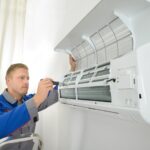Key Takeaways:
- Regular chimney maintenance ensures safety and efficiency.
- Understanding standard chimney issues can help in early detection.
- Professional inspections are crucial for comprehensive assessments.
- Essential DIY maintenance can prevent more significant issues from arising.
Introduction
Maintaining a chimney might not be at the forefront of a homeowner’s mind, but it’s essential for ensuring a safe and efficient heating system. Ignoring your chimney can lead to potential hazards, from fires to carbon monoxide poisoning. This article provides comprehensive tips and guidelines to help you maintain your chimney effectively.
Why Regular Chimney Maintenance is Important
Routine chimney care is not only focused on cleanliness; it also plays a crucial role in upholding the safety of your residence. One simple yet effective step you can take is to schedule regular chimney inspections to catch any issues before they become dangerous. A neglected chimney can lead to various dangerous scenarios, including fires and toxic fumes entering your living space. The buildup of creosote, a byproduct of burning wood, is particularly hazardous. Creosote is flammable and can easily cause a chimney fire if left untreated. The NFPA recommends checking chimneys annually for structural integrity, cleanliness, and proper clearances. This not only stops possible fires but also guarantees efficient operation of your heating system, leading to long-term savings on energy expenses.
Common Chimney Issues to Watch For
Understanding standard chimney inspections issues can help in early detection and prevention. Here are some problems to keep an eye on:
- Creosote Buildup: This is a highly flammable substance that accumulates inside your chimney flue and can cause chimney fires if not removed. Layers of creosote can restrict airflow and reduce the efficiency of your heating system.
- Blockages: Birds, leaves, and other debris can block your chimney, leading to poor ventilation. A blocked chimney can force smoke and toxic gases like carbon monoxide back into your home, posing a severe health risk.
- Cracks in the Flue: These can compromise the chimney’s structure and allow toxic gases to leak into your home. Over time, small cracks can expand and cause significant structural damage to your chimney, making repairs more costly.
The Role of Professional Inspections
While routine cleaning is something homeowners can often manage, professional inspections remain indispensable. Experts have the tools and knowledge to detect issues that might not be visible to the untrained eye. For instance, a professional might use a chimney camera to inspect the interior flue for hidden damage or blockages. According to the Chimney Safety Institute of America (CSIA), certified chimney sweeps follow strict guidelines to ensure thorough inspections and efficient cleaning. They can identify potential hazards, such as deteriorating chimney liners or masonry damage, that can be overlooked during a household inspection. Investing in a professional service can save you from future expenses and ensure your chimney is safe.
Essential DIY Chimney Maintenance Tips
Though professional inspections are crucial, some essential DIY maintenance can also be beneficial. Here are a few tips:
- Clean the Chimney Cap: Regular cleaning of the chimney cap can help prevent blockages. The chimney cap is designed to keep debris and animals out of the chimney. However, it can become clogged over time, obstructing airflow and causing inefficiencies.
- Check the Smoke Chamber: Ensure no cracks or creosote buildup could cause issues. The smoke chamber directs smoke from the firebox into the chimney flue. Regular inspection and cleaning can ensure that smoke travels correctly and reduces the risk of backdrafts into your home.
- Test the Damper: Ensure that the damper opens, closes, and seals properly. The damper controls the airflow in the chimney and is essential for efficient burning and preventing heat loss. If the damper is not sealing correctly, it can allow cold air into your home and increase your heating costs.
Seasonal Maintenance Considerations
Chimney maintenance should be a task that takes time. Different seasons bring different challenges for your chimney. In the fall, schedule a professional inspection before you start using your fireplace regularly. This ensures that your chimney is clear of debris and that any damage from the previous year is repaired. Make sure to inspect for any problems caused by winter, like ice damage, after using heavily throughout the spring season. Ice has the ability to widen existing cracks in the masonry, which can result in more serious problems if not dealt with quickly. Regular maintenance throughout the year can help you catch problems early and extend the life of your chimney.
Conclusion
Regular chimney maintenance is critical for ensuring the safety and efficiency of your heating system. You can keep your chimney in top condition by understanding common issues, scheduling professional inspections, and performing basic DIY tasks. Remember, a well-maintained chimney enhances safety and improves the performance of your heating system, keeping your home warm and cozy. Given the importance of these tasks, taking the time to maintain your chimney can lead to peace of mind and long-term cost savings, making it a worthwhile investment for any homeowner.




